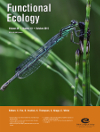 Male and female reviewers may rate papers the same way, regardless of whether the authors are male or female — but women are more likely to get the chance to review papers (and get their own papers reviewed) if other women are involved, according to studies of the review process at Functional Ecology.
Male and female reviewers may rate papers the same way, regardless of whether the authors are male or female — but women are more likely to get the chance to review papers (and get their own papers reviewed) if other women are involved, according to studies of the review process at Functional Ecology.
In their comprehensive study of manuscripts put through the peer review process at the journal from January 2004 through June 2014, the authors found that the average review scores of manuscripts was roughly the same regardless of whether the reviewer — or editor — was male or female.
The authors also scanned papers submitted to the journal between 2010 and 2014 to look at the impact of gender among authors, and also found papers with female authors receive equivalent scores to papers by men:
Papers with female authors (A) were equally likely to be sent for peer review, (B) obtained equivalent peer review scores, and (C) were equally likely to be accepted for publication, compared to papers with male authors. There was also no evidence that male editors or male reviewers treated papers authored by women differently than did female editors and reviewers, and no evidence that more senior editors reached different decisions than younger editors after review, or cumulative through the entire process, for papers authored by men versus women.
However, in the selection of reviewers and acceptance of the job of reviewing, the gender of the editors did appear to be associated with the gender of the reviewer, and vice versa:
[F]emale editors include a higher proportion of women among their selected reviewers than do male editors.
Which is to say, more female editors meant more women were asked to review articles. The gender differences seemed to be exacerbated among more senior editors, where
the proportion of women among selected reviewers declined with editor seniority, albeit only slightly, when the editor was male … but increased with editor seniority when the editor was female.
As to the gender of the reviewers who actually agreed to review the selected manuscript,
Overall, invitations from female editors were slightly less likely to be accepted than were invitations from male editors.
But when asked to review, female scientists were more likely to respond to invitations, and agree to review a manuscript, than men.
When they looked at authorship, Fox et al. found that there was also an interaction between the gender of authors and reviewers:
Papers authored by women were more likely to be reviewed by women. This is primarily because women were more likely to be invited to review if the authors on a paper were female than if the authors were male.
Authors, editors, and reviewers are still predominantly male, but those numbers changed over time, the researchers note in “Editor and reviewer gender influence the peer review process but not peer review outcomes at an ecology journal:”
The gender ratio of editors for Functional Ecology was majority male, but the proportion of female editors increased over time. The gender ratio of selected reviewers was also highly majority male, but the proportion of women selected as reviewers increased over the 10 years largely because the number of women on the editorial board increased and female editors invited more female reviewers than did male editors. Male editors selected <25% female reviewers even in the year they selected the most women, but female editors consistently selected ˜30–35% female reviewers.
Female authors were roughly one-third of all authors on submitted papers, the authors note in “Gender differences in patterns of authorship do not affect peer review outcomes at an ecology journal:”
Relative to overall frequency of authorship, women were underrepresented as solo authors (26% were women). On multi-authored papers, women were also underrepresented as last/senior authors (25% were women) but overrepresented as first authors (43% were women).
We asked the corresponding author and executive editor of the journal, Charles Fox, how well the findings about peer review — which included 4898 reviewers and 8288 associated reviews in Functional Ecology — would represent the behaviors in all scientific journals.
One must always be careful extrapolating from a single population (Functional Ecology editors and reviewers) to other disciplines. I am comfortable saying that I expect our results to be general for journals in ecology and evolution. This is because the editor and reviewer populations overlap substantially for most ecology and evolution journals. This won’t be true between ecology and other disciplines, some of which are much more male-dominated (e.g., economics) than is ecology. So I am hesitant to speculate more broadly than to ecology.
As to the gender differences shown in the processing of manuscripts? The authors state that their findings are (italics theirs)
consistent in indicating that peer review outcomes are gender-neutral, but that gender does influence some aspect of the peer review process.
Like Retraction Watch? Consider making a tax-deductible contribution to support our growth. You can also follow us on Twitter, like us on Facebook, add us to your RSS reader, and sign up on our homepage for an email every time there’s a new post. Click here to review our Comments Policy.